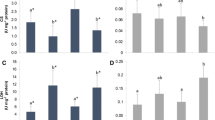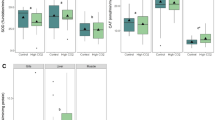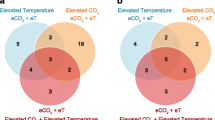Abstract
Sharks have maintained a key role in marine food webs for 400 million years and across varying physicochemical contexts, suggesting plasticity to environmental change. In this study, we investigated the biochemical effects of ocean acidification (OA) levels predicted for 2100 (pCO2 ~ 900 μatm) on newly hatched tropical whitespotted bamboo sharks (Chiloscyllium plagiosum). Specifically, we measured lipid, protein, and DNA damage levels, as well as changes in the activity of antioxidant enzymes and non-enzymatic ROS scavengers in juvenile sharks exposed to elevated CO2 for 50 days following hatching. Moreover, we also assessed the secondary oxidative stress response, i.e., heat shock response and ubiquitin levels. Newly hatched sharks appear to cope with OA-related stress through a range of tissue-specific biochemical strategies, specifically through the action of antioxidant enzymatic compounds. Our findings suggest that ROS-scavenging molecules, rather than complex enzymatic proteins, provide an effective defense mechanism in dealing with OA-elicited ROS formation. We argue that sharks’ ancient antioxidant system, strongly based on non-enzymatic antioxidants (e.g., urea), may provide them with resilience towards OA, potentially beyond the tolerance of more recently evolved species, i.e., teleosts. Nevertheless, previous research has provided evidence of detrimental effects of OA (interacting with other climate-related stressors) on some aspects of shark biology. Moreover, given that long-term acclimation and adaptive potential to rapid environmental changes are yet experimentally unaccounted for, future research is warranted to accurately predict shark physiological performance under future ocean conditions.



Similar content being viewed by others
References
Alamdari DH, Kostidou E, Paletas K, Sarigianni M, Konstas AG, Karapiperidou A, Koliakos G (2005) High sensitivity enzyme-linked immunosorbent assay (ELISA) method for measuring protein carbonyl in samples with low amounts of protein. Free Radic Biol Med 39:1362–1367
Bartosz G (2003) Total antioxidant capacity. In: Spiegel HE, Nowacki G, Hsiao K-J (eds) Advances in clinical chemistry, vol 37. Academic press, California, pp 220–272
Baum JK, Myers RA, Kehler DG, Worm B, Harley SJ, Doherty PA (2003) Collapse and conservation of shark populations in the Northwest Atlantic. Science 299:389–392
Baumann H, Talmage SC, Gobler CJ (2012) Reduced early life growth and survival in a fish in direct response to increased carbon dioxide. Nat Clim Chang 2:38–41
Bond U, Agell N, Haas AL, Redman K, Schlesinger MJ (1988) Ubiquitin in stressed chicken embryo fibroblast. J Biol Chem 263:2384–2388
Bradford MM (1976) A rapid and sensitive method for the quantitation of microgram quantities of protein utilizing the principle of protein-dye binding. Anal Biochem 72:248–254
Burnett LE (1997) The challenges of living in hypoxic and hypercapnic aquatic environments. Integr Comp Biol 37:633–640
Caldeira K, Wickett ME (2005) Ocean model predictions of chemistry changes from carbon dioxide emissions to the atmosphere and ocean. J Geophys Res 110:C09S04
Clements JC, Hunt HL (2014) Influence of sediment acidification and water flow on sediment acceptance and dispersal of juvenile soft-shell clams (Mya arenaria L.) J Exp Mar Biol Ecol 453:62–69
Dean JB (2010) Hypercapnia causes cellular oxidation and nitrosation in addition to acidosis: implications for CO2 chemoreceptor function and dysfunction. J Appl Physiol 108:1786–1795
Dickson A, Millero F (1987) A comparison of the equilibrium constants for the dissociation of carbonic acid in seawater media. Deep-Sea Res 34:1733–1743
Dixson DL, Munday PL, Jones GP (2010) Ocean acidification disrupts the innate ability of fish to detect predator olfactory cues. Ecol Lett 13:68–75
Doney SC, Ruckelshaus M, Duffy JE, Barry JP, Chan F, English CA, Galindo HM, Grebmeier JM, Hollowed AB, Knowlton N, Polovina J, Rabalais NN, Sydeman WJ, Talley LD (2012) Climate change impacts on marine ecosystems. Annu Rev Mar Sci 4:11–37
Feder ME, Hofmann GE (1999) Heat-shock proteins, molecular chaperones, and the stress response: evolutionary and ecological physiology. Annu Rev Physiol 61:243–282
Filho DW, Boveris A (1993) Antioxidant defences in marine fish—II. Elasmobranchs. Comp Biochem Physiol C 106:415–418
Frommel AY, Maneja R, Lowe D, Pascoe CK, Geffen AJ, Folkvord A, Piatkowski U, Clemmesen C (2014) Organ damage in Atlantic herring larvae as a result of ocean acidification. Ecol Appl 24:1131–1143
Gattuso J-P, Hansson L (2011) Ocean acidification: background and history. In: Gattuso J-P, Hansson L (eds) Ocean acidification. Oxford University Press, Oxford, pp 1–17
Hanna J, Meides A, Zhang DP, Finley D (2007) A ubiquitin stress response induces altered proteasome composition. Cell 129:747–759
Heinrich DDU, Rummer JL, Morash AJ, Watson S-A, Simpfendorfer CA, Heupel MR, Munday PL (2014) A product of its environment: the epaulette shark (Hemiscyllium ocellatum) exhibits physiological tolerance to elevated environmental CO2. Conservation Physiology 2(1):cou047–cou047
Heinrich DDU, Watson S-A, Rummer JL, Brandl SJ, Simpfendorfer CA, Heupel MR, Munday PL (2016) Foraging behaviour of the epaulette shark Hemiscyllium ocellatum is not affected by elevated CO2. ICES J Mar Sci: J Conseil 73(3):633–640
Heuer RM, Grosell M (2014) Physiological impacts of elevated carbon dioxide and ocean acidification on fish. Am J Physiol—Regul Integr Comp Physiol 307:R1061–R1084
Hoeijmakers JHJ (2009) DNA damage, aging and cancer. N Engl J Med 361(15):1475–1485
Hofmann GE, Barry JP, Edmunds PJ, Gates RD, Hutchins DA, Klinger T, Sewell MA (2010) The effect of ocean acidification on calcifying organisms in marine ecosystems: an organism-to-ecosystem perspective. Annu Rev Ecol Evol Syst 41:127–147
Hu M, Li L, Sui Y, Li J, Wang Y, Lu W, Dupont S (2015) Effect of pH and temperature on antioxidant responses of the thick shell mussel Mytilus coruscus. Fish Shellfish Immunol 46:573–583
Johansson LH, Borg LA (1988) A spectrophotometric method for determination of catalase activity in small tissue samples. Anal Biochem 174(1):331–336
Kambayashi Y, Binh NT, Asakura HW, Hibino Y, Hitomi Y, Nakamura H, Ogino K (2009) Efficient assay for total antioxidant capacity in human plasma using a 96-well microplate. J Clin Biochem Nutr 44:46–51
Kroeker KJ, Kordas RL, Crim RN, Singh GG (2010) Meta-analysis reveals negative yet variable effects of ocean acidification on marine organisms. Ecol Lett 13:1419–1434
Kumar R (2009) Role of naturally occurring osmolytes in protein folding and stability. Arch Biochem Biophys 49:1–6. https://doi.org/10.1016/j.abb.2009.09.007
Lawrence RA, Burk RF (1976) Glutathione peroxidase activity in selenium-deficient rat liver. Biochem Biophys Res Commun 71:952–958
Lesser MP (2006) Oxidative stress in marine environments: biochemistry and physiological ecology. Annu Rev Physiol 68:253–278
Lewis E, Wallace DWR (1998) CO2SYS-Program developed for the CO2 system calculations. Report ORNL/CDIAC-105
López-Cruz RI, Dafre AL, Filho DW (2012) Oxidative stress in sharks and rays. In: D Abele Vázquez-Medina JP, Zenteno-Savín T (eds) Oxidative stress in aquatic ecosystems. Wiley-Blackwell, Oxford, pp 157–163
Lund R, Grogan ED (2004) The origin and relationships of early Chondrichthyes. In: Musick JA, Carrier JC, Heithaus MR (eds) Biology of sharks and their relatives. CRC Press Inc, Boca Raton, pp 3–31
Lüthi D, Le Floch M, Bereiter B, Blunier T, Barnola J-M (2008) High-resolution carbon dioxide concentration record 650,000-800,000 years before present. Nature 453:379–382
MacLellan RJ, Tunnah L, Barnett D, Wright PA, MacCormack T, Currie S (2015) Chaperone roles for TMAO and HSP70 during hyposmotic stress in the spiny dogfish shark (Squalus acanthias). J Comp Physiol B 185:729–740
Maclouf J, Grassi J, Pradelles P (1987) Development of enzyme-immunoassay techniques for measurement of eicosanoids. In: Walden TL, Hughes HN (eds) Prostaglandin and lipid metabolism in radiation injury. Springer, New York, pp 355–364
McCord JM, Fridovich I (1969) Superoxide dismutase an enzymic function for erythrocuprein (hemocuprein). J Biol Chem 244:6049–6055
Mehrbach C, Culberson C, Hawley J, Pytkowicz R (1973) Measurement of the apparent dissociation constants of carbonic acid in seawater at atmospheric pressure. Limnol Oceanogr 18:897–907
Morrison J (1954) The activation of aconitase by ferrous ions and reducing agents. Biochem J 58:685–692
Nagelkerken I, Munday PL (2015) Animal behaviour shapes the ecological effects of ocean acidification and warming: moving from individual to community-level responses. Glob Chang Biol 22:974–989
Njemini R, Lambert M, Demanet C, Mets T (2005) Heat shock protein 32 in human peripheral blood mononuclear cells: effect of aging and inflammation. J Clin Immunol 25:405–417
NOAA (2017) Trends in atmospheric carbon dioxide. Global Greenhouse Gas Reference Network
Orr JC, Fabry VJ, Aumont O, Bopp L, Doney SC, Feely RA, Gnanadesikan A, Gruber N, Ishida A, Joos F, Key RM, Lindsay K, Maier-Reimer E, Matear R, Monfray P, Mouchet A, Najjar RG, Plattner G-K, Rodgers KB, Sabine CL, Sarmiento JL, Schlitzer R, Slater RD, Totterdell IJ, Weirig M-F, Yamanaka Y, Yool A (2005) Anthropogenic ocean acidification over the twenty-first century and its impact on calcifying organisms. Nature 437:681–686
Pamplona R, Constantini D (2011) Molecular and structural antioxidant defenses against oxidative stress in animals. Am J Physiol Regul Integr Comp Physiol 301:R843–R863
Pimentel M, Pegado MR, Repolho T, Rosa R (2014) Impact of ocean acidification in the metabolism and swimming behavior of the dolphinfish (Coryphaena hippurus) early larvae. Mar Biol 161:725–729
Pimentel MS, Faleiro F, Diniz M, Machado J, Pousão-Ferreira P, Peck MA, Pörtner HO, Rosa R (2015) Oxidative stress and digestive enzyme activity of flatfish larvae in a changing ocean. PLoS One 10:e0134082
Pistevos JC, Nagelkerken I, Rossi T, Olmos M, Connell SD (2015) Ocean acidification and global warming impair shark hunting behaviour and growth. Sci Rep 5:16293
Pörtner H-O, Karl DM, Cheung WWL, Lluch-Cota SE, Nojiri Y, Schmidt DN, Zavialov PO (2014) Ocean systems. In: Field CB, Barros VR, Dokken DJ, Mach KJ, Mastrandrea MD (eds) Climate change 2014: impacts, adaptation and vulnerabilities. part A: global and sectorial aspects contribution of working group II to the fifth assessement report of the intergovernmental panel on climate change. Cambridge, United Kingdom and New York, USA, pp 411–484
Ridgwell A, Zeebe RE (2005) The role of the global carbonate cycle in the regulation and evolution of the earth system. Earth Planet Sci Lett 234:299–315
Rosa R, Baptista M, Lopes VM, Pegado MR, Paula JR, Trübenbach K, Leal MC, Calado R, Repolho T (2014) Early-life exposure to climate change impairs tropical shark survival. Proc R Soc Lond B Biol Sci 281:20141738
Rosa R, Paula JR, Sampaio E, Pimentel M, Lopes AR, Baptista M, Guerreiro M, Santos C, Campos D, Almeida-Val VMF, Calado C, Diniz M, Repolho T (2016a) Neuro-oxidative damage and aerobic potential loss of sharks under elevated CO2. Mar Biol 163:119
Rosa R, Pimentel M, Galan JG, Baptista M, Lopes VM, Couto A, Guerreiro M, Sampaio E, Castro J, Santos C, Calado C, Repolho T (2016b) Deficit in digestive capabilities of bamboo shark early stages under climate change. Mar Biol 163:1–5
Rosa R, Rummer JL, Munday PL (2017) Biological responses of sharks to ocean acidification. Biol Lett 13:20160796
Rudneva II (1997) Blood antioxidant system of black sea elasmobranch and teleosts. Comp Biochem Physiol C Pharmacol Toxicol Endocrinol 118:255–260
Rudneva II (1999) Antioxidant system of Black Sea animals in early development. Comp Biochem Physiol C Toxicol Pharmacol 122:265–271
Rudneva II, Dorokhova II, Skuratovskaya EN, Kuz'minova NS (2014) Comparative studies of hepatic and blood biomarkers in three species of black sea elasmobranchs. Int J Mar Sci 4:1–14
Rummer JL, Munday PL (2016) Climate change and the evolution of reef fishes: past and future. Fish Fish 18:22–39
Sampaio E, Lopes AR, Francisco S, Paula JR, Pimentel M, Maulvault AL, Repolho T, Grilo TF, Pousão-Ferreira P, Marques A, Rosa R (2018) Ocean acidification dampens physiological stress response to warming and contamination in a commercially-important fish (Argyrosomus regius). Sci Total Environ 618:388–398
Sarazin G, Michard G, Prevot F (1999) A rapid and accurate spectroscopic method for alkalinity measurements in seawater samples. Water Res 33:290–294
Sejersted Y, Aasland AL, Bjørås M, Eide L, Saugstad OD (2009) Accumulation of 8-oxoguanine in liver DNA during hyperoxic resuscitation of newborn mice. Pediatr Res 66(5):533–538
Shen J, Deininger P, Hunt JD, Zhao H (2007) 8-hydroxy-2′-deoxyguanosine (8-OH-dG) as a potential survival biomarker in patients with nonsmall-cell lung cancer. Cancer 109:574–580
Silva CSE, Novais SC, Lemos MFL, Mendes S, Oliveira AP, Gonçalves EJ, Faria AM (2016) Effects of ocean acidification on the swimming ability, development and biochemical responses of sand smelt larvae. Sci Total Environ 563-564:89–98
Solé M, Rodríguez S, Papiol V, Maynou F, Cartes JE (2009) Xenobiotic metabolism markers in marine fish with different trophic strategies and their relationship to ecological variables. Comparative Biochemistry and Physiology, Part C 149:83–89
Sswat M, Stiasny MH, Jutfelt F, Riebesell U, Clemmesen C (2018) Growth performance and survival of larval Atlantic herring, under the combined effects of elevated temperatures and CO2. PLoS One 13(1):e0191947
Stiasny MH, Mittermayer FH, Sswat M, Voss R, Jutfelt F, Chierici M, Puvanendran V, Mortensen A, Reusch TBH, Clemmesen C (2016) Ocean acidification effects on Atlantic cod larval survival and recruitment to the fished population. PLoS One 11:e0155448
Stohs S, Bagchi D (1995) Mechanisms in the toxicity of metal ions. Free Radic Biol Med 18(2):321–336
Sunday JM, Calosi P, Dupont S, Munday PL, Stillman JH, Reusch TBH (2014) Evolution in an acidifying ocean. Trends Ecol Evol 29:117–125
Tomanek L (2010) Variation in the heat shock response and its implication for predicting the effect of global climate change on species’ biogeographical distribution ranges and metabolic costs. J Exp Biol 213:971–979
Tomanek L, Zuzow MJ, Ivanina AV, Beniash E, Sokolova IM (2011) Proteomic response to elevated P CO2 level in eastern oysters, Crassostrea virginica: evidence for oxidative stress. J Exp Biol 214:1836–1844
Uchiyama M, Mihara M (1978) Determination of malonaldehyde precursor in tissues by thiobarbituric acid test. Anal Biochem 86:271–278
Wang X, Wu L, Aouffen M, Mateescu M-A, Nadeau R, Wang R (1999) Novel cardiac protective effects of urea: from shark to rat. Br J Pharmacol 128:1477–1484
Wittmann AC, Pörtner H-O (2013) Sensitivities of extant animal taxa to ocean acidification. Nat Clim Chang 3:995–1001
Wood CM, Liew HJ, Boeck GD, Walsh PJ (2013) A perfusion study of the handling of urea analogues by the gills of the dogfish shark (Squalus acanthias). PeerJ 1:e33
Zeebe RE, Ridgwell A (2011) Past changes in ocean carbonate chemistry. In: Gattuso J-P, Hansson L (eds) Ocean acidification. Oxford University Press, Oxford, New York, pp 21–37
Acknowledgments
We would like to thank Eduarda Pinto for the fundamental technical support during the preparation of the experimental setup and shark acclimation.
Funding
The Portuguese Foundation for Science and Technology (FCT) supported this work through the project grant PTDC/AAG-GLO/1926/2014 and Programa Investigador FCT 2013 to R.R. FCT also supported this work through (i) the strategic project UID/MAR/04292/2013 granted to MARE and (ii) PhD grants to ARL (SFRH/BD/97070/2013), ES (SFRH/BD/131771/2017), CS (SFRH/BD/117890/2016), and MRP (SFRH/BD/111691/2015). Both PLM and JLR are supported by funding from the Australian Research Council (ARC) Centre of Excellence for Coral Reef Studies.
Author information
Authors and Affiliations
Corresponding author
Ethics declarations
Competing of interests
The authors declare that they have no conflicts of interest.
Rights and permissions
About this article
Cite this article
Lopes, A.R., Sampaio, E., Santos, C. et al. Absence of cellular damage in tropical newly hatched sharks (Chiloscyllium plagiosum) under ocean acidification conditions. Cell Stress and Chaperones 23, 837–846 (2018). https://doi.org/10.1007/s12192-018-0892-3
Received:
Revised:
Accepted:
Published:
Issue Date:
DOI: https://doi.org/10.1007/s12192-018-0892-3




